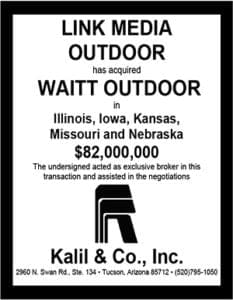
Insider’s Note: Richard Rothfelder is a Partner at Rothfelder & Falick and a frequent and welcome legal contributor at Billboard Insider.
During the last few days of its term, the US Supreme Court decided on June 21, 2019 an extremely important case, for both the outdoor advertising industry and Supreme Court jurisprudence, in Knick vs Township of Scott. Insider wrote about the decision in its June 24, 2019 edition, and it’s been widely reported in the media; but, in part because my clients and I have fallen victim to the Catch-22 trap in Williamson County vs Hamilton Bank, which was overruled by Knick, I wanted to weigh in as well.
In Knick, the Township of Scott, PA passed an ordinance requiring cemeteries to be open to the public during daylight hours. Rose Mary Knick, whose 90 acre rural property had a small family graveyard, was notified she was violating the ordinance. Knick filed suit in federal court under the Civil Rights Act, Section 1983, alleging the ordinance violated the Takings Clause of the Fifth Amendment. The federal district and appellate courts dismissed her claims under the 34 year old precedent in Williamson County vs Hamilton Bank, which held that property owners must seek just compensation for their property in state court under state law, before bringing a federal takings claim under Section 1983. The Supreme Court, in a 5 to 4 decision, overruled Williamson, and held that the federal courts have jurisdiction to entertain such inverse condemnation takings claims under Section 1983, without first exhausting state takings remedies.

Before reviewing its significant impact on billboard operators and other property owners, it’s important to note the decision was decided on traditional ideological grounds, with the four conservative justices (Thomas, Kavanaugh, Alito, and Gorsuch) in the majority, and the four liberal justices (Kagan, Ginsburg, Breyer, and Sotomayor) dissenting. As he has often done on this Court, Chief Justice Roberts broke the tie, this time siding with the conservatives, and he even authored the opinion.
In reaching its holding, it’s also interesting that the Majority had to abandon the Court’s usual adherence to stare decisis in expressly overruling its own decision in 1985 in Williamson. It is rare for the Court overrule it’s long-standing precedents, and raises questions about whether it would be willing to do so in other contexts, like in the hotly debated abortion case of Roe vs Wade.
The case certainly helps billboard operators, and the attorneys that represent them. We, as attorneys, will no longer be forced first file suit in state courts, under state statutes and constitutions, to redress our clients’ inverse condemnation claims arising from zoning ordinances, sign code, and other land use regulations. Typically, those state courts are occupied by elected judges, who may be susceptible to the prejudices often evident against a billboard company suing a local government. The remedies under state law are also often unsatisfactory, as they don’t include recoveries of attorneys fees, and require complex and duplicative administrative and legal proceedings. By contrast, federal judges are appointed for life, and they are generally considered less influenced by local politics and prejudices. Moreover, the Federal Civil Rights Act, Section 1983, affords the litigant who successfully demonstrates the deprivation of his constitutional rights broad recoveries, including attorneys fees, injunctions, and declaratory judgments. Finally, as the Court explained, the property owner will no longer suffer the Catch-22 trap in Williamson: “The takings plaintiff thus finds himself in a Catch-22. He cannot go to federal court without going to state court first; but if he goes to state court and loses, his claim will be barred in federal court. The federal claim dies aborning.”
So, good riddance to Williamson and it procedural Catch-22, and welcome to Knick and the apparently strong on property rights majority of the Supreme Court!
[wpforms id=”9787″]
Paid Advertisement

















